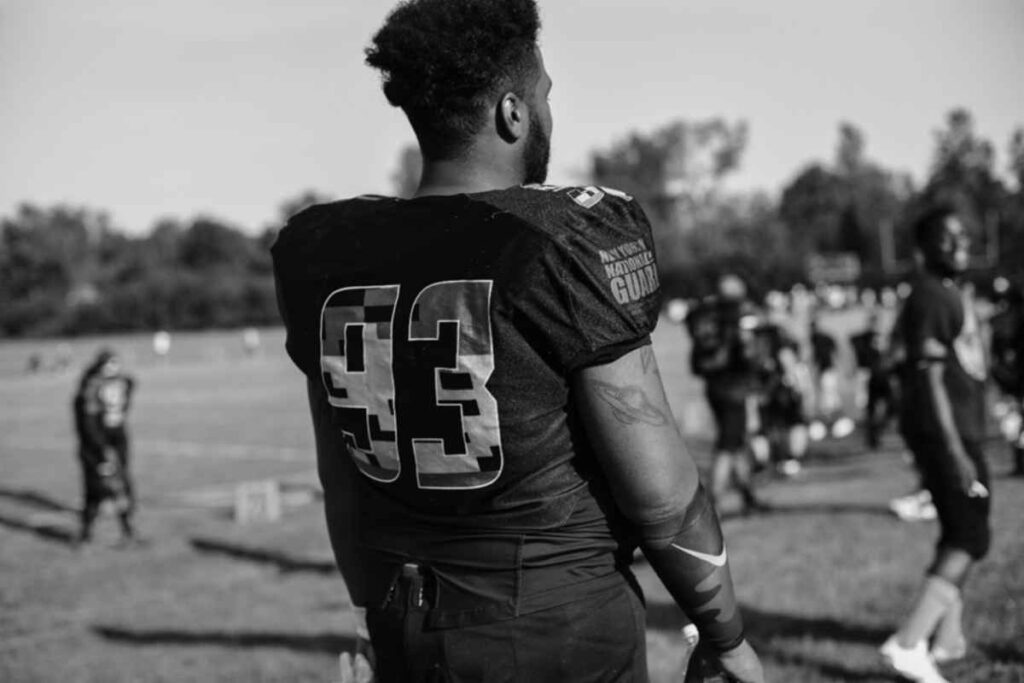Designing a sports team uniform is more than just choosing a jersey colour and printing names on the back. It’s about creating an identity. A great uniform can boost confidence, unite a team, energize fans, and even make your opponents take notice. It reflects your team’s personality and often becomes one of the most recognizable aspects of your brand.
Whether you’re designing for a high school team, an adult rec league, or a professional squad, your uniform plays a key role in how the team performs and how it’s remembered. Let’s walk through what it takes to design a sports uniform that truly wins.
7 easy steps you can follow to design the perfect sports team uniform.
When your players wear something they’re proud of, they walk onto the field already winning. Here are 7 tips you can follow to design a winning sports team uniform.
1. Start with a strong colour scheme that reflects your team’s identity
The right colour combination can influence both perception and performance. A study examined how uniform colours affected perceptions of athletes’ aggressiveness and fairness. Participants viewed images of athletes in red, blue, or green uniforms and judged those in red as more aggressive and more likely to win, while green uniforms were associated with fairness.
Ask yourself: what message should your team’s colours send? A youth soccer team might go for bright, energetic colours to show enthusiasm. A competitive hockey team might stick to bold, darker shades to project strength and grit. Once you’ve chosen your base colours, make sure they contrast well with your secondary shades and text. This helps ensure everything is easy to read from a distance.
Remember, simplicity is your friend. Limit your palette to two or three main colours and use them consistently across all uniform elements.
2. Choose the right materials and don’t ignore the stitching
Performance starts with comfort. Sports uniforms should be made from breathable, moisture-wicking fabrics that allow freedom of movement. Polyester and poly-cotton blends are common choices for team wear because they’re lightweight, durable, and easy to wash.
But the fabric is only half the story because construction matters, too. Reinforced stitching in high-stress areas (like shoulders, underarms, and seams) can make a big difference in durability over a season. This is especially important for contact sports or teams playing multiple games per week.
If you’re adding logos, team names, or patches, embroidery adds a professional touch that lasts long. Look for a local provider with experience in athletic wear. A quick search for shirt embroidery near me can help you connect with specialists who can customize gear to your exact needs.
3. Design a logo that’s bold, clean, and timeless
Think of your team logo as your badge of honor. It should be simple enough to be instantly recognizable and bold enough to make a statement. A good sports logo often includes a strong icon, clean typography, and clear symbolism that ties back to the team’s name or community.
Avoid overly intricate designs or tiny details that won’t translate well onto a jersey. Logos should be versatile enough to look sharp on everything from uniforms to water bottles to social media graphics. A great test? Shrink your logo down to 1 inch wide. If it still looks clean and readable, you’re on the right track.
If you’re creating a logo from scratch, consider hiring a graphic designer who specializes in sports branding. It’s an investment that will serve your team well for years to come.
4. Pay attention to fit and function for every player
Every athlete is different, and your uniforms should reflect that. Offering a wide range of sizes and fits ensures each player feels comfortable and confident. For youth teams, this might mean offering both relaxed and more athletic cuts. A study from Massey University highlighted that uniform design could impact female athletes’ confidence. Hence, for co-ed teams, it often helps to have separate fits for male and female players.
Comfort is more than just a nice perk. It’s part of the performance. Ill-fitting uniforms can restrict movement, cause irritation, and distract players during a game. When your athletes feel good in what they’re wearing, they’re more likely to stay focused and give it their all.
Think about the specific needs of your sport, too. Basketball uniforms should allow for maximum arm movement. Soccer jerseys should be lightweight and breathable. And football uniforms need room for padding underneath. Always factor these things in before finalizing your design.
5. Add personalization
Personal touches like player names and numbers give athletes a sense of ownership. But to maintain a professional, cohesive look, you need uniformity in placement, font choice, and sizing. Stick with fonts that are bold, clean, and easy to read from a distance, especially for sports like football or lacrosse, where jerseys might be viewed from the stands.
Make sure every player’s uniform follows the same formatting. This not only looks better but also helps referees, announcers, and fans identify players quickly during a game. And if your team plays in multiple leagues or tournaments, check for any rules about number size, placement, or name inclusion. Some organizations have very specific regulations you’ll need to follow.
6. Test your design in real life before you commit
Before placing a bulk order, create a prototype and test it out in action. Let players wear it during practice to see how it holds up to movement and sweat. Wash it a few times to make sure the colours don’t fade, and that embroidery or printing doesn’t peel or fray.
You’d be surprised how many teams skip this step and end up with uniforms that don’t perform well or don’t last the season. A test run lets you fix small issues before they become expensive problems. It also gives players a chance to give feedback, which helps ensure they’re happy with the final product.
7. Don’t forget the fans
A sharp-looking uniform isn’t just for players. It’s also for fans, families, and community supporters. A well-designed jersey or hoodie can double as team merch and generate excitement around the brand. If your design looks good off the field, people are more likely to wear it in the stands or around town. That’s a major incentive to get the design right, not just for performance, but for growing your team’s fan base.
Final Thoughts
The best team uniforms are the ones that combine function, style, and identity. They make your team feel united, look confident, and play their best. Every detail, from fabric and fit to logo design and embroidery, has the power to influence how your team is perceived and how players perform.
So, take your time. Test your design. Work with pros. And when in doubt, think about how the uniform will feel in the middle of a hard-fought game. Imagine how it’ll look when your team is holding the championship trophy.


